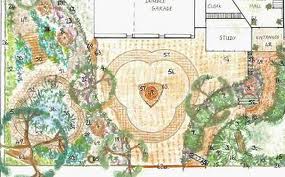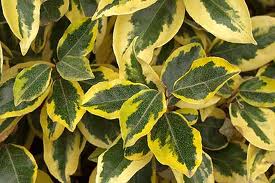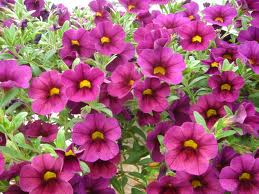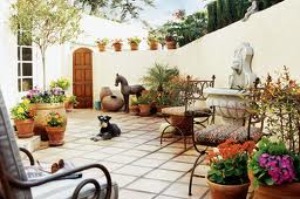





The art and skill of planning your garden both to look beautiful and to run efficiently throughout the year.
Before planning to alter your existing garden radically or beginning work on your new one, it is important to consider what it is you want from your plot. Is it to add value or interest, amaze your friends with your ecological or wild garden, or for the exercise? If you want to grow foods which ones do you want and when? After all, if you always go on holiday in midsummer, there is not much point in planting early apples. Similarly if you want flowers, are they for cutting or as outdoor beauty for you and your neighbours? All gardens need somewhere to sit, but are you going to be on a bench with the garden all around you, or have a more limited vista from a window? If you want privacy, effective screening may be more important than saving money or maximising self-sufficiency.
Once you know which are your most important parameters, it is easier to work around them. Plan a garden in the same way you would consider buying a newer car or refitting the kitchen, and similarly be prepared to spend realistic amounts of money initially. What you can have and what it costs in time, work and money do not just depend on the size of your garden. All the factors are interchangeable, money being the most easily converted into the others, but size remains the most important arbiter, with choice increasing as the garden enlarges.
 To make an effective plan it will help to make a map showing the boundaries, walls, pipelines, immovable objects, future building extensions, solid paths, trees, major shrubs and so on which are very difficult to alter. Given time and money anything is possible in garden design, but it is much easier to work around the permanent features rather than try to change everything.
To make an effective plan it will help to make a map showing the boundaries, walls, pipelines, immovable objects, future building extensions, solid paths, trees, major shrubs and so on which are very difficult to alter. Given time and money anything is possible in garden design, but it is much easier to work around the permanent features rather than try to change everything.
Use a pencil to mark the current areas of grass, vegetable plot, beds and borders as these can be altered at will. Choose the best sites for production — vegetables, the fruitcage and so on — then add other areas as your space allows. Work out your plan on paper first before translating it on to the ground as this saves much work and time. The plan helps you to see the garden as a whole and so organise it more rationally.
Try to get the maximum use out of each item, for example, place a store shed to shelter a bed and so that the biggest blank wall faces the sun for a trained fruit bush while it can also be part of the fencing for a fruit cage or hen run, the overflow from the shed water butts can be fed to another store or a pool, hedgehog nests put underneath the floor and bird boxes under the eaves.
While it is quite possible to be completely organic and pay no attention to aesthetics or even simple neatness, you are more likely also to want to make your garden a beautiful place, with harmonious lines and a natural placing and composition of all the elements. A certain instinct comes in to play here, and I believe that if it looks right it is right. However, some aspects of appearance are harder to achieve than others. I have broken these down into five basic elements which, combined, form the garden portrait as a whole. To make them easy to remember I have called them Framework, Foliage, Flowers, Features and Finish.
Because of its permanence through all seasons the bare bones or framework of any garden is especially important to have right, particularly when it is visible from frequently used windows. The outlines, shapes and views formed by the solid permanent features need to look good when there is little leaf or flower to help decorate or disguise them. The shapes and edges of beds and borders and paths are most important but pergolas, walls, hedges, trunks of trees and evergreens also create the solidity and endurance of any design, so great care needs to be taken with their laying out and positioning.
Once you have drawn up your plan, mock it up in the garden using canes and string, to try out different permutations before doing any work on the ground. A good idea is never to show all the garden from any one point so that there is a hint of more to discover. Create a hidden corner by extending the edge of a border or plant an island bed as an invitation to explore behind. Long, thin gardens can be made more interesting by breaking them up into a series of ‘rooms’ with a meandering path just giving glimpses of spaces beyond.
Paths can be tapered and curved to change perspective and make gardens seem larger or smaller in different directions. They should always lead to something, be it nothing more than an urn of flowers. Bending a path so that it disappears round a corner invites more exploration and trompe l’oeil steps leading nowhere at a boundary can give an impression of size and of more garden to discover.
Arches, gateways and pergolas add vertical interest and help heighten the feeling of rooms within rooms. They also allow smoother transition from one part of the garden to another with a different flavour, and block out unsightly objects and views. Remember that the closer the screen the lower it can be. The colours and materials making up the solid part of the framework tend to be more pleasing if they are compatible and consistent with their surroundings and each other. It helps to have all wood and timber work stained to the same hue; try also to use local materials, preferably recycled ones, within a single area or throughout the whole garden.
Although welcomed in the spring and appreciated in the autumn, during summer deciduous foliage is noticed, if at all, as a backdrop for the flowers. Yet foliage is also important in its own right, the many different forms, textures, colours and scents adding new levels of interest to any planting. Carefully selecting and combining these creates a more unified appearance than concentrating on flowers alone. One might even dispense with flowers entirely, as many plants have beautiful leaf colour and not only in the autumn. Some, such as the poplar Populus candicans ‘Aurora’ and Jasmine stephanense, have brilliantly coloured new leaves in the spring and there are countless plants with variegated leaves in many patterns and shades adding more colour.
 Many evergreens such as Elaeagnus, Euonymus and holly, have forms with white and yellow variegated and coloured leaves and these are especially useful for brightening dull winter days and dark corners. Evergreens contribute much to the feeling of permanence in a garden and need to be considered along with the framework to give year-round interest, though too many can give a sombre tone. The many shades and variety of evergreens plus the golds, reds and blues of conifers and heathers create colourful gardens that remain almost unchanged throughout the year.
Many evergreens such as Elaeagnus, Euonymus and holly, have forms with white and yellow variegated and coloured leaves and these are especially useful for brightening dull winter days and dark corners. Evergreens contribute much to the feeling of permanence in a garden and need to be considered along with the framework to give year-round interest, though too many can give a sombre tone. The many shades and variety of evergreens plus the golds, reds and blues of conifers and heathers create colourful gardens that remain almost unchanged throughout the year.
Once established, these gardens require little maintenance but they are hard to blend in with many settings. Evergreens, especially ivy, are useful for providing shelter, nest and hibernation sites for beneficial insects and animals; for this reason alone, as well as for aesthetic reasons, some should be included in each part of the garden.
The effect of foliage, particularly of the young growths of herbaceous plants, is enhanced if there is multiple planting. Single specimens can give a spotty appearance which is reinforced when the flowers come out. Most plants look best when grouped in threes, fives and sevens. Obviously this is not always practical, but generally in a bed with say three dozen plants, the effect will be better with two groups of seven, two of five and four of three than with 36 different ones. Deliberate and frequent repetition of a favourite plant in various areas can add much to the unity and ambience of the garden until it almost becomes a theme.
 A garden is incomplete without flowers, not only because of their beauty but because they provide nectar and pollen for beneficial insects. The organic gardener wishing to increase the total life within the garden must ensure a constant succession of flowers using as many and as varied plants as possible to nurture and sustain the maximum number and variety of creatures. Of course, flowers are followed by seeds and berries, which then feed other beneficial insects and animals and so their value is increased. To us, these fruits may be as attractive as, or even better than, the flowers they follow, as is the case with holly berries and Gladwyn iris. Naturally few berries last for long, though those in unusual colours, such as yellow pyracanthas, last longest.
A garden is incomplete without flowers, not only because of their beauty but because they provide nectar and pollen for beneficial insects. The organic gardener wishing to increase the total life within the garden must ensure a constant succession of flowers using as many and as varied plants as possible to nurture and sustain the maximum number and variety of creatures. Of course, flowers are followed by seeds and berries, which then feed other beneficial insects and animals and so their value is increased. To us, these fruits may be as attractive as, or even better than, the flowers they follow, as is the case with holly berries and Gladwyn iris. Naturally few berries last for long, though those in unusual colours, such as yellow pyracanthas, last longest.
Growing flowers for their beauty it is a matter of personal taste. There are plenty of theories for composing colour mixtures with emphasis on the harmony of colours, avoiding or promoting some combinations, as with single-shade borders or all white flowers. However some people seem to like violent discords and splattered paint box effects, others go for pastel shades and gentle gradations while many just want masses of colour. There is only one way to find out what works for you and your situation, no matter how much planning and viewing of other’s efforts you do beforehand: make notes of what works and what does not and, if you get it wrong, change the plants around as soon as they can be moved. No garden is ever finished, it can always be improved! As with foliage, constant repetition throughout the garden and multiple plantings of the same flowering plant, where space allows, generally creates a stronger impression than many assorted single specimens.
These are the decoration on the cake and should not overwhelm or replace it. Features can be anything from classical statuary to a dead wheelbarrow full of gnomes. Water in any form, pergolas, timber work, rustic arbours, urns and containers, special beds and specimen plants can all be features. It is setting and positioning that make them effective. As noted above, every path should lead to something and the path then makes it significant. Too many features, though, and the garden becomes a junkyard. One main feature in each view, area or ‘room’ is usually sufficient. Particularly nice scenes are much improved with a seat for viewing them and this itself creates the centrepiece for another small picture, but should not be in competition. In fact no garden is complete without a seat, or many; though these are seldom used by the toiling gardener, they greatly benefit others and help give that atmosphere of relaxation we strive for so vigorously.
 Themes are subtle features whereby individual areas or the garden as a whole have some common attribute. A water or a wild garden is a theme, as are scented gardens, historical gardens, silver borders and herb beds. The danger with themes as with features is that they can become overpowering or constraining if followed too rigidly. Set the theme broadly and leave yourself room to manoeuvre. A wildlife garden that uses only native plants will have to leave out such charmingly useful ones as buddleias and pyracanthas.
Themes are subtle features whereby individual areas or the garden as a whole have some common attribute. A water or a wild garden is a theme, as are scented gardens, historical gardens, silver borders and herb beds. The danger with themes as with features is that they can become overpowering or constraining if followed too rigidly. Set the theme broadly and leave yourself room to manoeuvre. A wildlife garden that uses only native plants will have to leave out such charmingly useful ones as buddleias and pyracanthas.
A garden of all black flowers is going to be harder to achieve than a border of silver foliage and black flowers. A bed can have more variation and colour if it is to attract bees and butterflies rather than one or the other. In the organic garden (which is in a way a theme itself), some features and themes are especially pertinent as they interact and benefit the life in the garden so much – ponds and other sources of water, wildflower gardens, native plants, beehives and bee gardens. Others may be worthy in their own right, such as wildlife sanctuaries and gardens of endangered plants be they wild flowers, rare fruits or old varieties of vegetable.
Just using particular forms of plant about the garden can create a subtle theme without being too obvious. Spiky leaves like those of yucca and Crocosmia can give a drier, warm, Mediterranean appearance, while Chusan palms, bamboos and large-leafed plants like figs give a lush tropical effect. I even had an Opuntia prickly pear cactus outside in a sunny spot for years and used a cloche over it only in the depth of winter till a damp spring and slugs got it. Conifers, heathers and silver birches give a colder heath like effect, while rampant climbers rapidly create an enclosed feeling (and the reality).
Of all features and themes, scent is my favourite and I have consciously selected as many scented plants as possible so that my garden is a feast as much for the nose as for the eye.
Finishing touches and immaculate tidiness make for the most perfect gardens (with much labour) and ignoring them spoils the overall effect disproportionately. Most importantly get rid of every bit of litter and junk; have a glory hole to hide away anything you cannot bring yourself to dispose of entirely. Junk includes anything that is not intended as a feature so garden tools, pots, canes, string and buckets are best tidied into a shed rather than left exposed. The edging of turfed areas is critical; little improves the appearance of a garden more than neat, well-cut edges and the removal of tufts of grass growing up against trunks and fences.
Uniformity helps, too. One plastic cloche made from an empty lemonade bottle looks unsightly, three dozen cut the same look neat. When adding to anything in the garden or repairing a fence, say, try to blend the new in with the old by painting them all the same. Most timber work can be stained to a similar hue and a coat of black bituminous paint will give an enduring, inexpensive and sympathetic finish to metal.
Copyright © www.100flowers.win Botanic Garden All Rights Reserved